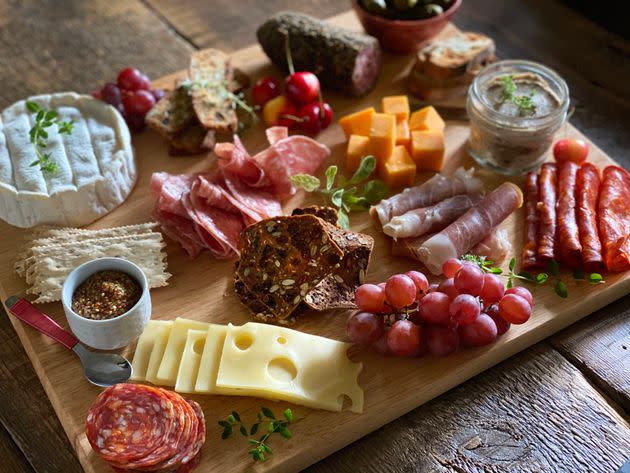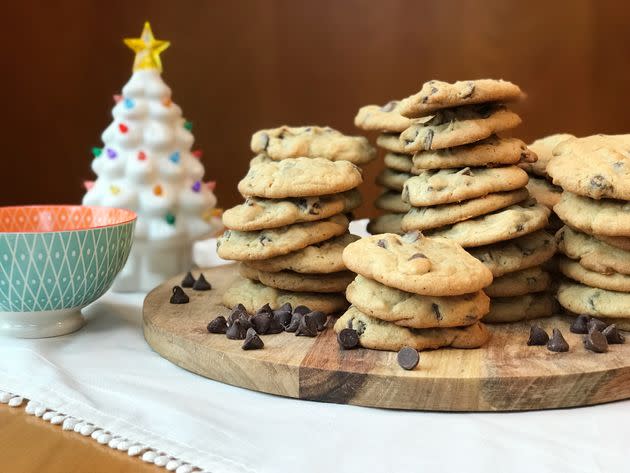Having A Holiday Party? Here's How Long You Can Leave Food Out On The Table

The best part of a holiday party is arguably the food spread, featuring tables full of meats and cheese, holiday roasts and other ingredients that are probably sitting out at room temperature for way too long. The worst part of a holiday party is the puking and diarrhea that may follow.
We spoke with food safety experts to find out everything you need to know to throw a realistic party without giving everyone a foodborne illness (we know you can’t be shuttling food back and forth to the refrigerator every two hours).
The average person can’t tell if food has gone bad.
Part of the challenge of keeping guests healthy is that “it is never easy to tell if food has gone bad for an average person,” said Jagdish Khubchandani, a professor of public health at New Mexico State University who specializes in food safety. While most people can tell if a food is so far gone that it’s no longer edible, foods may look, taste and smell fine but still be “full of germ growth,” which can make you sick, he said.
Although following food-safety rules may be a pain, “having guests get sick from your party food is way worse than following the rules from the start,” said Trevor Craig, a food safety expert and corporate director of technical training and consulting at Microbac Laboratories. While most people bounce back from foodborne illnesses quickly, you may risk more than giving your guests a tummy ache. Each year in America, 48 million people get sick, 128,000 are hospitalized, and 3,000 die from a foodborne pathogen, according to the Centers for Disease Control.
The good news is that “almost all food can be left out if you keep it in safe conditions,” Craig said.
First, make sure cooked foods are thoroughly cooked.
Foods like meat, chicken, turkey, seafood and eggs need to be cooked at a high enough internal temperature to kill all bacteria, according to Darin Detwiler, the chair of the National Environmental Health Association’s Food Safety Program and author of “Food Safety: Past, Present, and Predictions.” If not eradicated, this bacteria can easily multiply, especially if left out on a table for a couple of hours.
The United States Department of Agriculture has a guide to safe internal temperatures to ensure no germs are left behind. Most cooked foods need to reach an internal temperature of between 145 to 165 degrees Fahrenheit to be safe to eat. Use an inexpensive food thermometer to be sure your appetizers or dinner have reached a high enough internal temperature.
Know the highway to the “danger zone.”
We here at HuffPost are constantly preaching about the “danger zone.” If you still don’t know what it is, it refers to the temperature range between 40 and 140 degrees Fahrenheit. You should never leave food in that range for more than two hours. “Bacteria can grow rapidly in the danger zone,” Detwiler explained, so it’s important to keep food outside of this range.
Keep in mind that your refrigerator should be set to around 40 degrees, so anything warmer than your fridge in the room-temp range is likely in the danger zone.
Keep Hot Foods Hot
Even if foods are cooked to the ideal temperature, they still need to be kept hot to prevent bacteria from growing. Detwiler explained that cooked dishes should not be kept out for over two hours, and the clock starts as soon as the food is done cooking and includes time prepping the food for serving and travel time.
If you need to leave food out longer, Detwiler said it’s important to use a heating source (such as a chafing dish or heat lamp) to keep cooked foods above 140°F. However, leaving food out for even an hour can “encourage dangerous bacteria to grow, and that bacteria doesn’t need to get into high counts before it can make people sick,” Craig said. For that reason, he prefers to keep hot foods “hot for the whole time and not risk it.”
Keep Cold Foods Cold
Just like hot foods need to be kept hot, cold foods need to be kept cold. Cold foods like cheeses and potato salad should not be left out for more than two hours unless hosts have a way to keep them under 40°F.
One way to do that is by placing ice under the dish that needs to be kept cold. An easy way to do this is to fill an aluminum pan with ice and place the dish inside. This is easier to do with some foods than others. For example, dips can easily be placed in a bowl of ice and still look nice for serving. However, it’s more challenging to keep bigger dishes cold.
To keep foods from warming up to an unsafe temperature, Detwiler recommends “placing small amounts on the table or serving counter, while leaving the rest in the refrigerator” until ready to serve. This is especially important for foods with “heavy dairy content” like cheese and foods that contain raw eggs like deviled eggs, he said.

The good news: These are fine to leave sitting out all night.
What about nonperishable foods?
Foods such as cookies and chips that are stored at room temperature “aren’t a big risk if left out at room temperature,” Craig said. According to Detwiler, chips, cookies and other nonperishable foods are great “early offerings” to leave out for when guests arrive since they can be left out much longer.
How to further mitigate your risks.
Although it may sound obvious, Detwiler said it’s essential to wash your hands before handling food. He also recommends limiting the number of people who handle food.
Additionally, when serving food, each dish should have its own serving tool to avoid the risk of cross-contamination. “Provide the tools your guests need to treat your food right, making sure everything has their own serving tools so nothing gets moved around,” Craig said.
Detwiler also recommends serving more vulnerable guests first. This includes children under 5, the elderly, individuals with a compromised immune system and those who are pregnant.
Is it safe to eat the leftovers the next day?
It depends on how they were served at the party.
“You can keep leftovers as long as you stored them correctly while eating. If you didn’t or are unsure, it’s better to toss them,” Craig said. That’s because “some bacteria produce toxins, which cooking won’t get rid of,” he said. Moreover “a lot of bacteria can survive cold and even frozen conditions.”
Even for food that was served safely, Khubchandani cautions that “food should be refrigerated or frozen as soon as possible after people finish eating.” Food should never be left out for more than one or two hours before storing because “the longer you leave food out, the higher the chance of contamination and food going bad,” he said.
It’s also important to eat leftovers quickly. “Unless you want someone to get sick, leftovers should only be kept in the refrigerator for three to four days,” Detwiler said. Frozen leftovers can stay good for up to six months, he said.

